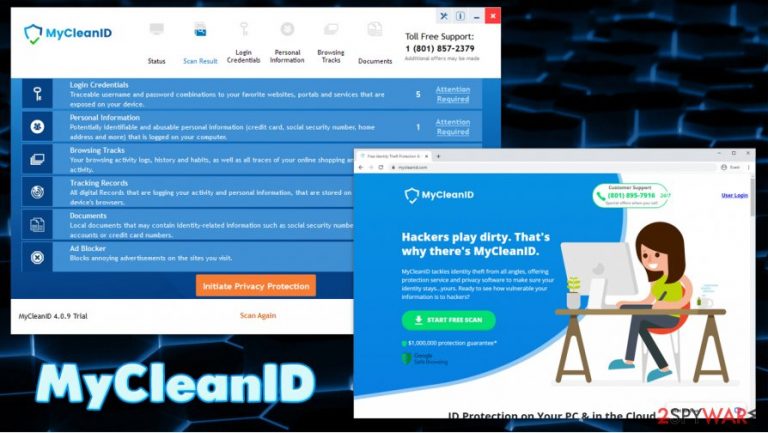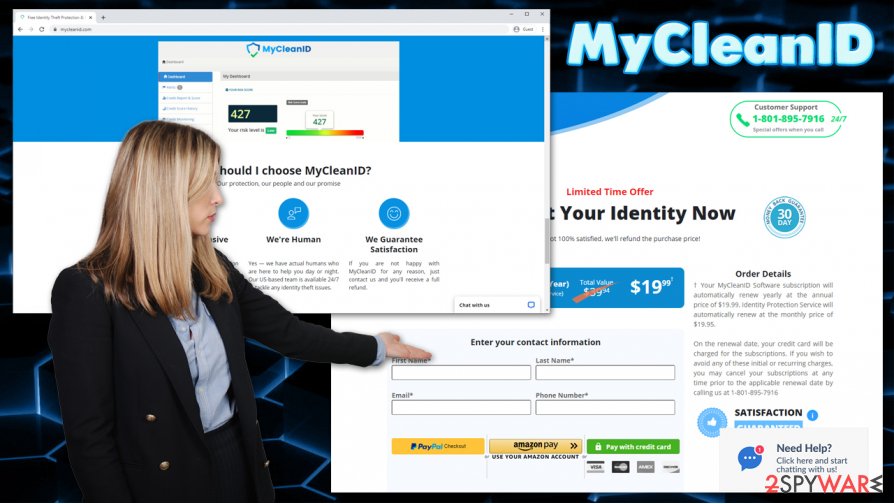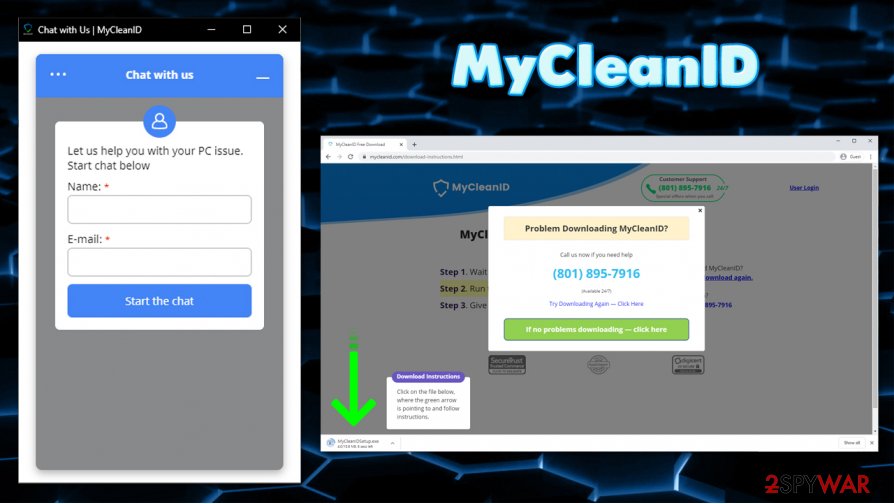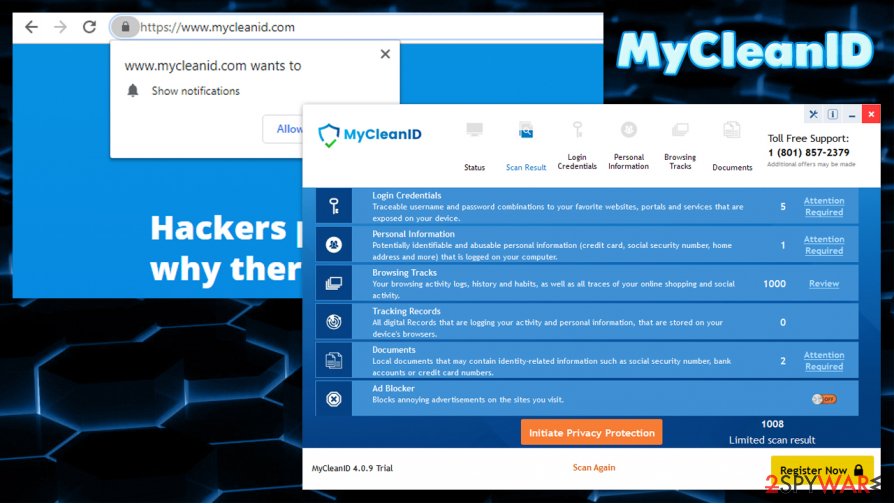MyCleanID (Easy Removal Guide) - Free Instructions
MyCleanID Removal Guide
What is MyCleanID?
MyCleanID is a potentially unwanted application that claims to protect your privacy

MyCleanID is an application that you could have downloaded from its official website or found it on your computer seemingly out of nowhere. In case you belong to the latter group of people, it is highly likely that you installed the app unintentionally with a freeware app from a third-party website. Deceptive distribution tactics are just one of the reasons why this app is considered to be a potentially unwanted program.
MyCleanID is presented as a program capable of protecting you from cyberattacks by letting you delete all the online traces. However, there are plenty of red flags when it comes to it, and the main problem is scan results and the way they are presented to users. The results are presented in a way to make users worried about their online safety due to hundreds of entries that are shown. The truth is, most of the presented entries are OK to have on a secure machine, as there is no need to delete them. In other words, MyCleanID might exaggerate scan results in order to make users purchase its full version.
| Name | MyCleanID |
|---|---|
| Type | Potentially unwanted program, system optimizer |
| Distribution | Software bundles, official website, advertisements on various websites |
| Concerns | The app shows exaggerated scan results and misleads users about their online privacy and security status. If the computer would be breached by data-stealing malware, it would not stop personal data compromise |
| Elimination | To get rid of unwanted apps manually, you can follow our removal guide below |
| Further steps | If you need tools to repair system after a malware infection or random stability issues, you can employ FortectIntego |
If you are wondering why MyCleanID is considered to be a PUP despite being a seemingly useful application capable of preventing identity theft and similar privacy issues, there are a few things you should understand.
As soon as it is installed on the machine, it begins to act suspiciously. Just as similar apps, it performs a full system scan immediately. During this time, users can also see a popup that asks users to enter their personal information such as Email and Name – this information is meant to help them to contact some type of support (which nobody asked for).
During the scan, MyCleanID shows thousands of entries that apparently need to be deleted due to privacy issues. They are divided into the following categories:
- Login Credentials
- Personal Information
- Browsing Tracks
- Tracking Records
- Documents
While the categories look good, what's shown in the scan results is not. The app seemingly implies that all the account information used to login to Microsoft, Google, or other account is not secure to have on your machine. Additionally, even “browsing records” that are essentially your browsing history are presented as something that needs to be deleted due to alleged privacy risks. In other words, MyCleanID treats every record on the PC as a potential privacy concern or compromise, which is not a correct approach to take.

MyCleanID also creates a scheduled task that allows the app to deliver intrusive popups – these show misleading information about user account security and reminds that a full license should be purchased in order to secure this data from alleged cyberattacks.
Some users also reported that MyCleanID operated a suspicious scam attempt when an online helpline was called. According to the user, the support asked him to connect to his computer remotely and then asked to provide payments of $200 for an alleged “protection plan.”[1]
To sum up, securing your information is extremely important, and there are plenty of steps that should help you with that. However, this program is not it – you should simply remove MyCleanID. If malware manages to access your computer, this app will not be able to stop the intrusion, and, even if it reports about the unauthorized access, the damage will be done already. Thus, rely on security tools such as SpyHunter 5Combo Cleaner or Malwarebytes for your online security and privacy protection.
When it comes to MyCleanID removal, you can easily eliminate the app by accessing the Control Panel. If you need a complementary tool to your security software to delete all the unwanted program leftovers and fix malware damage, experts[2] recommend trusting FortectIntego.
Protect your online security and privacy without installing PUPs on your device
It is true that data breaches have been plaguing companies along with its users for a few years now. To make matters worse, ransomware developers of such strains such Maze can now steal sensitive data and publish it online if the institution or the company does not agree to pay the ransom. In a recent event, a hacker published sensitive information of Las Vegas students after the school district refused to pay the ransom.[3]

In suchlike events, users can suffer a major negative impact on their privacy and can also be targeted by a future phishing attempt. Unfortunately, there is little that can be done to protect such information if the company responsible for it leaks it online due to a cyberattack or a similar event.
As explained above, the app is not sufficient to help one to protect their online data from cybercriminals. Instead, you should employ the following protection measures that should be sufficient to protect your privacy:
- Do not install potentially unwanted or malicious programs on your machine (avoid torrents, software cracks, etc.);
- Employ powerful anti-malware software that could prevent the infiltration of Trojans, ransomware, and other malicious software that could affect your personal files;
- Clean the web browser cache and data from time to time;
- Employ a reputable password manager that would encrypt your data;
- Never reuse your passwords if you are not using a password manager;
- Enable two-factor authentication (2FA) on all accounts.
Remove MyCleanID from your computer
As a general rule, you should not install apps on your system you are not certain of. However, since more and more users are concerned about their privacy due to the increased number of data breaches and malware infections, seemingly privacy-focused PUPs can get the momentum and be downloaded by millions of people, despite providing only a false sense of security in return for its license. This is why MyCleanID removal is something that security experts recommend – potentially unwanted programs are generally useless.

You should not encounter too many difficulties when trying to remove MyCleanID from your machine. Simply access the list of the installed applications, as explained below, and uninstall it fully. Alternatively, some security programs could delete the program for you automatically.
You may remove virus damage with a help of FortectIntego. SpyHunter 5Combo Cleaner and Malwarebytes are recommended to detect potentially unwanted programs and viruses with all their files and registry entries that are related to them.
Getting rid of MyCleanID. Follow these steps
Uninstall from Windows
To delete the app from Windows systems, proceed with the following steps:
Instructions for Windows 10/8 machines:
- Enter Control Panel into Windows search box and hit Enter or click on the search result.
- Under Programs, select Uninstall a program.

- From the list, find the entry of the suspicious program.
- Right-click on the application and select Uninstall.
- If User Account Control shows up, click Yes.
- Wait till uninstallation process is complete and click OK.

If you are Windows 7/XP user, proceed with the following instructions:
- Click on Windows Start > Control Panel located on the right pane (if you are Windows XP user, click on Add/Remove Programs).
- In Control Panel, select Programs > Uninstall a program.

- Pick the unwanted application by clicking on it once.
- At the top, click Uninstall/Change.
- In the confirmation prompt, pick Yes.
- Click OK once the removal process is finished.
Remove from Microsoft Edge
Delete unwanted extensions from MS Edge:
- Select Menu (three horizontal dots at the top-right of the browser window) and pick Extensions.
- From the list, pick the extension and click on the Gear icon.
- Click on Uninstall at the bottom.

Clear cookies and other browser data:
- Click on the Menu (three horizontal dots at the top-right of the browser window) and select Privacy & security.
- Under Clear browsing data, pick Choose what to clear.
- Select everything (apart from passwords, although you might want to include Media licenses as well, if applicable) and click on Clear.

Restore new tab and homepage settings:
- Click the menu icon and choose Settings.
- Then find On startup section.
- Click Disable if you found any suspicious domain.
Reset MS Edge if the above steps did not work:
- Press on Ctrl + Shift + Esc to open Task Manager.
- Click on More details arrow at the bottom of the window.
- Select Details tab.
- Now scroll down and locate every entry with Microsoft Edge name in it. Right-click on each of them and select End Task to stop MS Edge from running.

If this solution failed to help you, you need to use an advanced Edge reset method. Note that you need to backup your data before proceeding.
- Find the following folder on your computer: C:\\Users\\%username%\\AppData\\Local\\Packages\\Microsoft.MicrosoftEdge_8wekyb3d8bbwe.
- Press Ctrl + A on your keyboard to select all folders.
- Right-click on them and pick Delete

- Now right-click on the Start button and pick Windows PowerShell (Admin).
- When the new window opens, copy and paste the following command, and then press Enter:
Get-AppXPackage -AllUsers -Name Microsoft.MicrosoftEdge | Foreach {Add-AppxPackage -DisableDevelopmentMode -Register “$($_.InstallLocation)\\AppXManifest.xml” -Verbose

Instructions for Chromium-based Edge
Delete extensions from MS Edge (Chromium):
- Open Edge and click select Settings > Extensions.
- Delete unwanted extensions by clicking Remove.

Clear cache and site data:
- Click on Menu and go to Settings.
- Select Privacy, search and services.
- Under Clear browsing data, pick Choose what to clear.
- Under Time range, pick All time.
- Select Clear now.

Reset Chromium-based MS Edge:
- Click on Menu and select Settings.
- On the left side, pick Reset settings.
- Select Restore settings to their default values.
- Confirm with Reset.

Remove from Mozilla Firefox (FF)
Remove dangerous extensions:
- Open Mozilla Firefox browser and click on the Menu (three horizontal lines at the top-right of the window).
- Select Add-ons.
- In here, select unwanted plugin and click Remove.

Reset the homepage:
- Click three horizontal lines at the top right corner to open the menu.
- Choose Options.
- Under Home options, enter your preferred site that will open every time you newly open the Mozilla Firefox.
Clear cookies and site data:
- Click Menu and pick Settings.
- Go to Privacy & Security section.
- Scroll down to locate Cookies and Site Data.
- Click on Clear Data…
- Select Cookies and Site Data, as well as Cached Web Content and press Clear.

Reset Mozilla Firefox
If clearing the browser as explained above did not help, reset Mozilla Firefox:
- Open Mozilla Firefox browser and click the Menu.
- Go to Help and then choose Troubleshooting Information.

- Under Give Firefox a tune up section, click on Refresh Firefox…
- Once the pop-up shows up, confirm the action by pressing on Refresh Firefox.

Remove from Google Chrome
To protect your privacy, you should regularly clean your web Chrome browser as explained below:
Delete malicious extensions from Google Chrome:
- Open Google Chrome, click on the Menu (three vertical dots at the top-right corner) and select More tools > Extensions.
- In the newly opened window, you will see all the installed extensions. Uninstall all the suspicious plugins that might be related to the unwanted program by clicking Remove.

Clear cache and web data from Chrome:
- Click on Menu and pick Settings.
- Under Privacy and security, select Clear browsing data.
- Select Browsing history, Cookies and other site data, as well as Cached images and files.
- Click Clear data.

Change your homepage:
- Click menu and choose Settings.
- Look for a suspicious site in the On startup section.
- Click on Open a specific or set of pages and click on three dots to find the Remove option.
Reset Google Chrome:
If the previous methods did not help you, reset Google Chrome to eliminate all the unwanted components:
- Click on Menu and select Settings.
- In the Settings, scroll down and click Advanced.
- Scroll down and locate Reset and clean up section.
- Now click Restore settings to their original defaults.
- Confirm with Reset settings.

Delete from Safari
Remove unwanted extensions from Safari:
- Click Safari > Preferences…
- In the new window, pick Extensions.
- Select the unwanted extension and select Uninstall.

Clear cookies and other website data from Safari:
- Click Safari > Clear History…
- From the drop-down menu under Clear, pick all history.
- Confirm with Clear History.

Reset Safari if the above-mentioned steps did not help you:
- Click Safari > Preferences…
- Go to Advanced tab.
- Tick the Show Develop menu in menu bar.
- From the menu bar, click Develop, and then select Empty Caches.

After uninstalling this potentially unwanted program (PUP) and fixing each of your web browsers, we recommend you to scan your PC system with a reputable anti-spyware. This will help you to get rid of MyCleanID registry traces and will also identify related parasites or possible malware infections on your computer. For that you can use our top-rated malware remover: FortectIntego, SpyHunter 5Combo Cleaner or Malwarebytes.
How to prevent from getting adware
Stream videos without limitations, no matter where you are
There are multiple parties that could find out almost anything about you by checking your online activity. While this is highly unlikely, advertisers and tech companies are constantly tracking you online. The first step to privacy should be a secure browser that focuses on tracker reduction to a minimum.
Even if you employ a secure browser, you will not be able to access websites that are restricted due to local government laws or other reasons. In other words, you may not be able to stream Disney+ or US-based Netflix in some countries. To bypass these restrictions, you can employ a powerful Private Internet Access VPN, which provides dedicated servers for torrenting and streaming, not slowing you down in the process.
Data backups are important – recover your lost files
Ransomware is one of the biggest threats to personal data. Once it is executed on a machine, it launches a sophisticated encryption algorithm that locks all your files, although it does not destroy them. The most common misconception is that anti-malware software can return files to their previous states. This is not true, however, and data remains locked after the malicious payload is deleted.
While regular data backups are the only secure method to recover your files after a ransomware attack, tools such as Data Recovery Pro can also be effective and restore at least some of your lost data.
- ^ MyCleanid scareware scam (801) 895-7916. Scammer.info. Scam report forum.
- ^ Lesvirus. Lesvirus. Cybersecurity advice and malware insights.
- ^ A hacker published thousands of students' grades and private information after a Nevada school district refused to pay ransom. Business Insider. Aaron Holmes.
